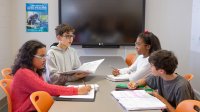Planning for Student Engagement
Keeping middle school students actively learning in remote classes was tough. Some of the strategies teachers used will work well in the classroom.
Your content has been saved!
Go to My Saved Content.Teaching during the pandemic helped some of us teachers evolve to meet the needs of students by making adjustments to how we planned lessons. New instructional strategies emerged around how to deliver and apply content, including modifying traditional approaches, such as the gallery walk, and developing new strategies, like designing memes to demonstrate learning.
For the best engagement, teachers need to plan to make sure that students can learn in different formats. At the middle school level it’s especially imperative that we vary how we deliver content to students—how we introduce information, and how students apply, use, and evaluate that information. Here are some planning strategies that will help ensure strong student engagement.
Planning Stage
Engagement: Consider the engagement factor when creating assignments. During planning, ask yourself, “Is this something I would want to do? Will the students view this as meaningful?” The answers will help you consider how engaged students will likely be with the lessons.
Purpose: Decide on the purpose for learning new content. Reasons for introducing new content can include developing understanding for an upcoming unit, practicing a skill, and assisting in making connections between events.
Organization: In introducing content, the purpose will help determine how to organize the students, including grouping and your role. Introduce students to content individually, in pairs, in small groups, or through a whole-class task. Your role can include clarifying student responses, asking questions, or correcting misconceptions.
Delivery: The method for delivering new content to students is important. For example, teachers can select a news clip to help make connections about the present to the past, share a multiperspective article on the topic, or develop a simulation to engage with new material.
Adapting Strategies
Making the in-person gallery walk virtual: Adapt the traditional gallery walk so that students can learn at their own pace and apply their learning from anywhere. For example, following the creation of a product such as a Google Slide, students can visit other students’ work through a link. Students can provide feedback in the form of comments and questions, increase their knowledge by recording big takeaways, or collect more in-depth information on a new topic.
Brainstorm, cluster, and evaluate: Another traditional strategy involves brainstorming ideas on sticky notes, grouping them based on similarities, and conducting peer evaluation. To convert this to a digital assignment, use Google Jamboard. Assign student groups a Jamboard and colored sticky notes for brainstorming. Students label and categorize the responses with their group. As with the virtual gallery walk setup above, students evaluate the work of their peers by leaving comments. A strategy like this involves all group members throughout all phases of the activity.
DYOM (design your own meme): One way to foster engagement is for students to demonstrate their learning through creating something that’s familiar. Designing a meme allows students to choose an image related to the content and add a short phrase that communicates their understanding of the content and what they learned from class.
Emoji-fy content: Most students use emojis to share their feelings and communicate, so why not let them use emojis to share what they’ve learned about new content? Ask them to choose several emojis to represent the meaning, and for each emoji they select, students can include a short caption explaining their choice. For example, in science, when students learn photosynthesis, they might choose a sun, water droplets, a person breathing, and a tree. Students can describe each of the emojis to demonstrate their understanding of this concept.
RAFT: This stands for Role, Audience, Format, and Topic and is a lifesaver for engagement. It gives students choices about how to evaluate their work and show their understanding. The teacher gives students choices over the four categories. For example, in social studies, following the study of the Boston Tea Party (topic), students can choose from several roles, including that of a British soldier, a patriot, or a loyalist. The audience can be the colonists or British government. The format is where students have the greatest amount of flexibility. They can choose to write a letter, develop an infographic, or create a podcast.
Giving students the choice and flexibility to demonstrate understanding is one of the most important factors in student engagement. If this school year has taught us anything, it’s that teachers have the ability to creatively plan to engage students in any setting. The lessons we’ve learned from this year in terms of best practices and the revision of practices used prior to the pandemic should continue to be our goal as educators.
